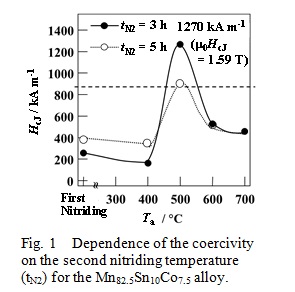(ESICMM-G8 Symposium on Next Generation Permanent Magnets, Tsukuba, 2015)
Improvement of Magnetic Properties of Nd-Fe-B Magnet Powders and A Research for Development of New-type Permanent Magnets
Satoshi Sugimoto and Masashi Matsuura (Tohoku University)
Yasuhiro Une, Hirokazu Kubo and Masato Sagawa (Intermetallics Co., Ltd.)
Abstract:
1. Introduction
Nd-Fe-B sintered magnets are widely used in many applications. Recently, the development of Dy-free or Dy-lean Nd-Fe-B sintered magnets with high heat resistance and coercivity have been strongly demanded. On the other hand, the development of new-type magnets has also gotten a lot of attention. In this talk, recent progress of a technique for obtaining high coercive Nd-Fe-B magnets and a research for aiming to develop a new-type magnet in our laboratory will be introduced.
2. Dy saving technique
Decreasing grain size of the Nd2Fe14B phase is an established method for increasing coercivity of Nd-Fe-B sintered magnets. We decreased the size of jet-milled powder to around 1 μm by He jet-milling (He-JM) in Dy-free Nd-Fe-B sintered magnets and obtained high coercivity (μ0HcJ) of 2 T with (BH)max of around 400 kJm-3 [1]. We also succeeded further decrease in the size to 0.3 μm by combining HDDR, hydrogen decrepitation (HD) and He-JM [2, 3]. Recently, the effects of annealing and grain boundary diffusion (GBD) process [4] on coercivity were investigated. GBD processed powder showed high μ0HcJ of 2.0 T after annealing at 600 oC. From TEM analyses, Nd-rich phase was observed on the surface of the powder.
3.Search for new-type magnets
No material which shows higher magnetic properties than Nd-Fe-B magnets has been found. However, we recently found that Mn-Sn-Co-N alloys show high coercivity comparable to rare earth magnets. [5, 6] Figure 1 shows dependence of the coercivity on the second nitriding temperature for the Mn82.5Sn10Co7.5 alloy. The alloy showed high μ0HcJ of 1.59 T and two phase microstructure consisting of a perovskite phase and a β-Mn phase. TEM observation revealed that many twins were induced in the perovskite phase. It is considered that the microstructure is related to high coercivity.
References
[1] Y. Une and M. Sagawa, J. Japan Inst. Met., 76, 12, (2012) (in Japanese).
[2] M. Nakamura et al., Appl. Phys. Lett., 103, 022404, (2013).
[3] M. Nakamura et al., Mater. Trans. 55, 1582, (2014).
[4] H. Nakamura et al, IEEE Trans. Magn., 41, 3844, (2005).
[5] K. Isogai et al., Material Transactions, 54, 7, (2013), 1236-1239.
[4] K. Sinaji et al., Materials Transactions, 54, 10, (2013), 2007-2010.
Acknowledgement
These studies were partially supported by NEDO, JST-CREST or ESICMM.
